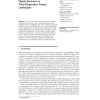Free Online Productivity Tools
i2Speak
i2Symbol
i2OCR
iTex2Img
iWeb2Print
iWeb2Shot
i2Type
iPdf2Split
iPdf2Merge
i2Bopomofo
i2Arabic
i2Style
i2Image
i2PDF
iLatex2Rtf
Sci2ools
ALIFE
2004
2004
Digital Evolution in Time-Dependent Fitness Landscapes
We study the response of populations of digital organisms that adapt to a time-varying (periodic) fitness landscape of two oscillating peaks. We corroborate in general predictions from quasi-species theory in dynamic landscapes, such as adaptation to the average fitness landscape at small periods (high frequency) and quasistatic adaptation at large periods (low frequency). We also observe adaptive phase shifts (time lags between a change in the fitness landscape and an adaptive change in the population) that indicate a low-pass filter effect, in agreement with existing theory. Finally, we witness long-term adaptation to fluctuating environments not anticipated in previous theoretical work.
| Added | 16 Dec 2010 |
| Updated | 16 Dec 2010 |
| Type | Journal |
| Year | 2004 |
| Where | ALIFE |
| Authors | Ye Li, Claus O. Wilke |
Comments (0)

